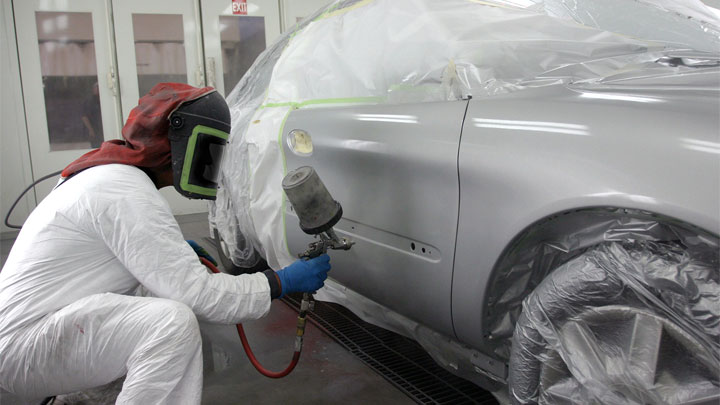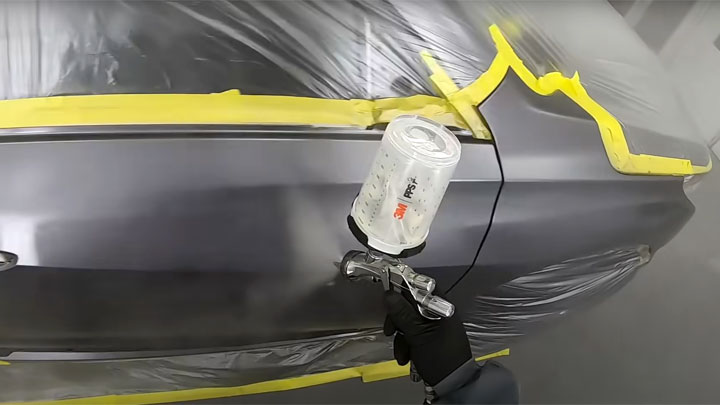How Long Does Clear Coat Take to Dry (and Cure)?
Your car’s paintjob is a multifaceted puzzle and the clear coat is the final piece bringing it all together. This transparent layer magnifies any paint’s vibrancy and preserves the richness.
But how long until it’s dry and fully cured? And when can you wash and wax it? Let’s look at a clear coat’s timeline from application to drying to vulnerability.

Related: How to Detail a Car Exterior (Comprehensive Guide)
What is a Clear Coat?
A vehicle’s paint job generally consists of three basic layers.
- The first of these layers is referred to as primer. Primer prepares a bare-metal surface for paint application, by providing a smooth, uniform base on which to paint.
- The second layer of a vehicle’s paint job is the actual pigmented paint that is recognized by the naked eye. A layer of thin, translucent resin is then applied on top of this paint, providing a seamless finish.
- This final layer of paint is referred to as a clear coat.
The clear coat is responsible for giving a vehicle’s paint its natural sheen, or wet appearance. This final coating also protects a vehicle’s paint from damage, at the hands of naturally-occurring environmental wear and tear. This wear and tear includes the effects of wind-carried abrasives, UV, and rain.
How Long Does It Take for Clear Coat to Dry to the Touch?

In general, clear coat takes anywhere from 12-48 hours to dry to the touch.
At this point, a vehicle’s clear coat is at little to no risk of prematurely flaking or chipping, and will also resist smearing. From this point forward, a vehicle can be driven with no ill effect, though care should be taken to protect the vehicle from becoming scratched or dinged.
How Long Does It Take for Clear Coat to Cure?
Clear coat actually takes much longer to cure than one might expect. As a general rule, a clear coat can take up to 30-days to fully cure, though this window of time can be slightly shorter or longer, based upon certain environmental factors.
In the absolute best case scenario, certain types of clear coats have been known to cure and harden in a matter of less than a week.
If you plan applying a car wrap, PPF (paint protection film), vinyl decals, or even Plasti Dip, it’s highly recommended you make sure the clear coat is fully cured or you will likely have problems down the road.
Factors That Affect Drying and Curing Time

As mentioned above, the drying and curing times for clear coats vary substantially, based upon a number of factors. Each of these factors directly affects the speed at which clear coat completes the outgassing process, and begins to set up.
The following are several of the most important of these factors.
#1 – Temperature
The temperature at which clear coat is applied definitely affects its overall drying and curing times.
As a general rule, the colder the temperature, the longer it takes for clear coat to set up and dry. At the other end of the spectrum, warm dry environments are ideal for quick clear coat drying times.
#2 – Humidity
In the bulk of cases, high humidity is responsible for lengthened clear coat drying times. For this reason, many body shops favor the use of climate controlled paint stalls, which eliminate many otherwise uncontrollable variables.
Under most circumstances, a painter would hope for a day of moderate temperatures, and low relative humidity.
#3 – Surface Prep

The state of the surface that is to be clear coated also affects the drying time of the clear coat itself. The more expertly a vehicle’s base coat of paint has been laid, the more adhesion any overlayed clear coat will have.
As a result, clear coat applied over skillfully painted vehicles often dry faster than anticipated.
See Also: Car Wrap vs Paint
How to Dry Clear Coat Faster
Drying clear coat can sometimes be a lengthy process, but there are a few methods you can use to speed it up.
Using a Hair Dryer
One way to expedite the drying process of clear coat on a small area is by using a hair dryer. Set your hair dryer to the low setting and focus the airflow on the area where the clear coat was applied.
Be sure to keep a safe distance so the heat doesn’t damage the paint underneath. This will help evaporate any moisture in the clear coat and aid in faster drying.
Exposure to Sunlight
You can take advantage of the sun’s natural UV rays to speed up the drying time. Keep your vehicle in a spot that receives direct sunlight for a few hours. The sun’s warmth will help the clear coat dry faster, while the UV rays can aid in the curing process.
However, be mindful of the outdoor temperature, as excessive heat may damage the paint. If you live in the Pacific NW and it’s not summer, this method is probably not for you.
Proper Environment
You’ll want your freshly clear coated car in the right environment to dry efficiently. Factors like temperature, humidity, and air circulation play huge roles in the drying process.
Ideally, the area should be dry and have a temperature between 65-85°F. Maintain proper air circulation with the help of fans or vents, but avoid creating excessive dust or debris, which can settle on the wet clear coat and cause defects in the finish.
How Soon Can I Wash My Car?
A car should never be washed any sooner than 30-days following clear coat application. This stems from the fact that most clear coats are still curing and hardening during this time.
The introduction of soaps/detergents to a vehicle’s newly painted exterior can easily compromise this curing process, thereby damaging the clear coat itself.
If in doubt, contact the body shop which applied your vehicle’s clear coat, before washing your vehicle for the first time. They should have all pertinent data on hand and should be able to provide you with an exact measure of time that should have elapsed before washing your vehicle.
It’s also best to contact the body shop if you happen to get bird poop, road tar, or other material on a freshly painted vehicle. Removal of these may cause more harm than good if you use the wrong product or method.
How Soon Can I Wax My Car?

Most paint manufacturers specify that motorists should not wax their vehicle any sooner than 60-90 days, following the application of a clear coat. Again, this stems from the need for clear coat to fully cure and harden before being disturbed by foreign agents, including those found within automotive body wax.
Furthermore, during the curing process, all paint, including clear coat, should be allowed to breathe in an unabated fashion. If using a car buffer to apply wax, take special car over corners and edges where the clear coat is often the thinnest.
A failure to heed such directions can result in a less than optimal finished appearance, to your vehicle’s newly applied clear coat. In many cases, a body shop will also void any warranty that was supplied with the vehicle’s paint job, due to negligence upon a motorist’s behalf.
This leaves your vehicle in less than optimal shape, and you, the motorist, without any real level of recourse.
See Also: 9 Recommended Car Polishers for DIYers
Common Clear Coat Issues
After applying clear coat to your vehicle, you might face some common issues. Here, we’ll discuss these issues more in-depth.
Improper Adhesion
One of the main concerns when applying a clear coat is achieving proper adhesion to the surface. Without proper adhesion, your clear coat might not bond correctly, leading to an uneven and unattractive finish. Factors that can cause improper adhesion include:
- Contaminants on the surface, such as dirt, dust, and grease
- Incorrect surface preparation and sanding
- Incompatible products or incorrect mixing ratios
To prevent improper adhesion, it’s critical to thoroughly clean and prepare the surface before applying the clear coat.
Peeling
Clear coat peeling can occur if the clear coat has not bonded properly to the surface. This problem might happen due to factors such as:
- Improper surface preparation and cleaning
- Incorrect application, such as applying the clear coat too thinly or too quickly between coats
- Exposure to harsh environmental conditions and sunlight
To prevent peeling, take the time to properly clean and prepare the surface, apply the clear coat according to the manufacturer’s recommendations, and ensure that the clear coat has enough time to dry between coats.
Scratches
Scratches on your clear coat can be both frustrating and unsightly. They can be caused by everyday wear and tear, washing your vehicle with abrasive materials, or even minor accidents. To minimize the occurrence of scratches:
- Avoid automatic, drive-through car washes
- Wash your vehicle with soft wash mitts or sponges
- Use a gentle, paint-safe car wash solution
- Avoid parking in tight spaces or close to other vehicles
If you do notice scratches on your clear coat, expert detailing services can help polish and remove them to restore your vehicle’s appearance.
See Also:
- Car Temperature Gauge Stopped Working? (Here’s Why) - Apr 15, 2024
- Ignition Coil vs Coil Pack (What’s the Difference?) - Apr 8, 2024
- Windshield Wipers Won’t Turn Off? (Causes and What to Do) - Apr 5, 2024
